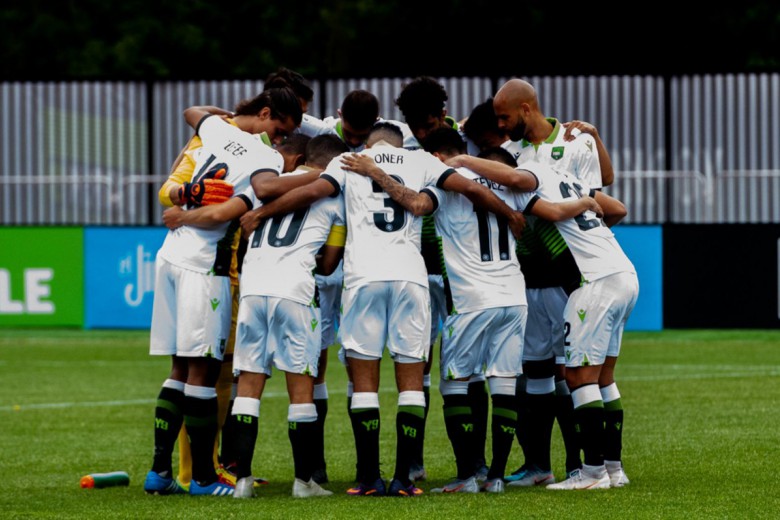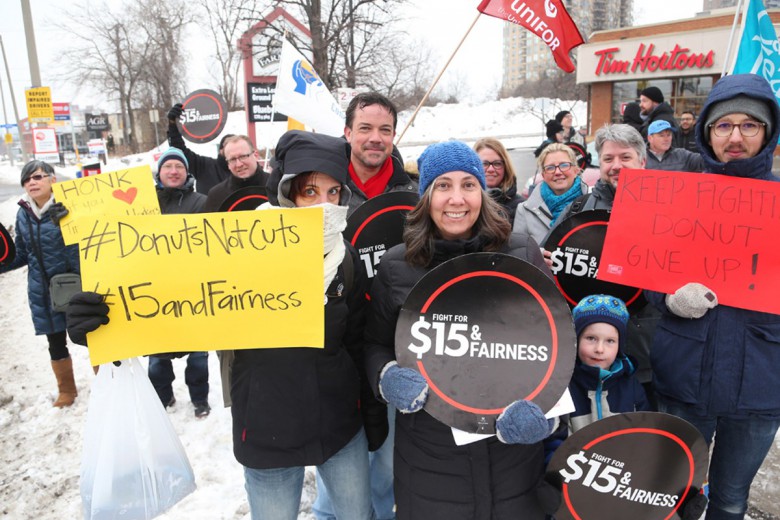
Patrick Kyle
Auto parts manufacturer Sodecia’s management likes to brag that, in its London, Ontario stamping facility, “The need for speed is still alive and well.” Its workers know this best, and the workload has driven them to try to unionize several times – only to encounter management’s anti-union campaigns.
The most recent time, however, organizers were prepared. “We had done campaigns in Sodecia before,” Justin Gniposky, Unifor’s director of organizing, shares. “We knew how many workers, what schedules, the number of clerical workers between the two plants, and what kind of bargaining unit we’d apply for.”
But beyond those data points, Gniposky says that management’s own claims provided a key linchpin for the organizing campaign. “We had folks who were outspoken in the workplace and were leafleting outside,” he recalls, prompting management to hold a captive audience meeting. There, company representatives denounced the union drive as a threat to the company’s business model.
Organizers had prepared for this and quickly challenged management’s bankruptcy claims. “We said, ‘show us your books, if you say you’re going bankrupt,’” Gniposky recalls. The union’s swift response and close relationship with workers ensured they wouldn’t be intimidated by management’s messaging. “We worked with our inside committee and these myths fell apart,” states Gniposky.
“These folks stood up to an employer with a long history of anti-union activity – you can too.”
And then they accelerated the union drive. “We do the mapping,” he explains. “How many people work this shift, how many people go back and forth between the facilities and go through conversations with the workers. We look at the geography – what’s the catchment? We draw a circle around the plant.”
By March 2023, the union’s strategy had held out and they secured a successful vote to join Unifor. “Now we can say ‘these folks stood up to an employer with a long history of anti-union activity – you can too,’” Gniposky exclaims.
Every prior attempt by Sodecia workers to unionize had failed against management’s staunch anti-union campaigns. As soon as union organizers penetrated the workplace, management did its research, prepared anti-union messaging, and successfully launched a campaign to defeat the drive. It was a battle for the geography of the workplace, time, and workers’ morale. For Sodecia workers, preparing for management’s anti-union campaign from the beginning was the key to a successful union drive.
“Employer discretion”
York University labour studies professor Stephanie Ann Ross says bosses across Canada are increasingly turning to a “layer of anti-union consultants” to help them lead anti-union campaigns.
“Employers without a union have the right to determine the conditions of work and they have no obligation to consult the employees unless they wish to. That’s employer discretion.”
Every union drive, Ross says, is about wresting that power from the employer.
“A lot of the calls I get are from workers who say if they had an advocate in their workplace, they would have had their issue solved,” United Food and Commercial Workers’ Ontario region director Debora De Angelis shares. “It really depends on what stage the organizing drive is [at] and how involved the employer’s anti-union campaign is. We’ve won better wages, health and safety, and an advocate at work.”
“We’re not fucking robots. Yet we’re expected to work like robots.”
In these campaigns, Ross says, the employer and its representatives try to scare the workers out of unionizing. “You always expect to lose a percentage of card signers in the vote because the employer is going to intervene.”
Successful organizing strategies and tactics will differ from workplace to workplace. But alongside losing card signers to last-minute employer interference, organizing experts say there are a couple of other steps that are common across union drives. Organizers will have to research issues that workers care about – such as occupational health and safety, wages, and benefits – and strategically use those issues to catalyze a union drive while staying under management’s radar for as long as possible.
Raising complaints at work, for example, may attract the ire of your boss. But it’s also how workers at a number of Indigo stores found success, De Angelis says. At Square One Shopping Centre in Mississauga during the first year of the COVID-19 pandemic, management ordered Indigo workers to clean and sanitize the store without any extra personal protective equipment or wage incentives. Workers signed a petition to let management know that these duties and working conditions were unacceptable and organizers used workers’ health and safety concerns to push for unionization.
“We’ve won better wages, health and safety, and an advocate at work.”
Wen Zhuang, a spokesperson for the Emergency Workplace Organizing Committee (EWOC), which has spearheaded the current wave of Starbucks union drives in the U.S., says EWOC leverages the needs and positions of the workers in their workplace against the mega-corporation.
Zhuang explains that the EWOC offers workers “a set of methods that train workers to build collective power through proper leadership development, methodic organizing conversations and relationship building, and a credible plan to win. These methods are transferable regardless of the workplace, the size of the workforce, or the nature of the workplace itself.”
The problem, De Angelis warns, is that union-busting methods are also often transferable, and employers are desperate to keep working conditions under their control. “Employers are looking at what’s happening globally,” she says. They’re watching Amazon’s union-busting tactics and learning how to apply these to their own workplaces.
Amazon’s cafeteria wars
For nearly a year, Quebec’s Confédération des syndicats nationaux (CSN) has been organizing Montreal’s massive Amazon fulfillment centre. Organizers learned everything they could about the facility and its workers – including the number of workers, their schedules, their positions, and how long workers have held those positions – to leverage as much power as possible against the mega-corporation, despite some hiccups early on in the organizing drive.
“The main organizer was a bit brash,” CSN organizer Marc Paquette remembers. “In the cafeteria, when people were taking their breaks together, he climbed up on a chair and yelled ‘if the shit is going to stay the same, we’ll go talk to a union. Give me your phone number, we’ll see a union!’ He hadn’t even contacted us yet.”
“People gave him this number. And, two days after, we were having a meeting,” Paquette says.
Employers are watching Amazon’s union-busting tactics and learning how to apply these to their own workplaces.
But management began its campaign, too. In the Montreal fulfillment centre, Paquette notes, Amazon brought in union-busting organizers to try to counter the union’s flyering with one-on-one meetings to intimidate workers.
“After Amazon found out about the union drive, they did a lot of profiling, and it was very clear that they did a thorough job of assessing who would sign a union card and who would not,” Paquette recalls. “I don’t think the workers bought the bullshit, but I think it had the effect of scaring people.”
Amazon’s one-on-ones are infamous across the country. “Amazon really likes to do this one-on-one thing – I’ll talk to you and no one else. It’s clearly a way to quell the anger,” explains Daisy,* an Amazon fulfillment centre worker in southern Ontario. Meanwhile, she exclaims, “people say on the floor all the time, ‘we’re not fucking robots.’ Yet we’re expected to work like robots.”
To counter the company’s intimidation efforts, Paquette says union supporters drafted a map of the plant. “The research we did was parallel to the union drive. We got a sense of how the distribution centre works, in-bound, out-bound, how the workplace operates. It gives us a sense of the list – how many workers are on the payroll to gather more than 60 per cent support – and to get an idea of where our leaders need to be and how they can communicate with each other.”
The “green mile”
Both unions and anti-union managers often see the struggle over a union drive in geographic terms.
Gniposky explains that mapping the workplace’s geography – finding out where workers enter and exit the building, take breaks, and park their cars or get on the bus – is key to all organizing drives. For example, Honda’s plant in Alliston, Ontario, is gated and massive, making it difficult for organizers to speak with workers.
Other workplaces are smaller with more obvious entrances and break spaces, like the Casino Niagara and the Fallsview Casino Resort in Niagara Falls. Organizers waited on the sidewalk in front of the casino’s main entrance to intercept workers at the end of their shifts, and in 2009, 2,700 casino workers voted to unionize with Canadian Auto Workers (CAW) Local 199.
But management fought back and used the casino’s layout to their advantage, deploying union-busting tactics and preventing the union from organizing more workers.
Then-CAW Local 199 president Wayne Gates told a local paper at the time that after promising to create full-time jobs in the region, the employer was making the work more and more precarious. “They’ve gone to part-time and contract employees,” Gates said.
“Most people have a gut reaction to the idea of having a conflict in the workplace. [...] That is part of the reality of the employment relation in our economy. You can’t get away from conflict. It’s a question of how that conflict is expressed.”
“The momentum and excitement that has built up in the past months clearly demonstrates that workers believe they will be best served by a union in these workplaces,” said former CAW president Ken Lewenza.
At the time, Casino Niagara spokesman Greg Medulun suggested that the company would not interfere. “We’ve created a corporate culture that allows our associates to work in an environment of dignity and respect in which they’re not only free but encouraged to bring any employment issues to our attention,” Medulun told Niagara This Week. “We also recognize the ability of our associates to make informed decisions in matters relating to their employment, and we’ll always respect those decisions.”
But after the union secured a base of at least 1,400 card signatures, management escalated its anti-union campaign.
“The employer used to have a place where workers were dropped off to get into the casino,” Ross recalls. “And the employers wallpapered the tunnel, the “green mile,” with pictures of basically a graveyard of factories that had been shut down. The implication was that these were unionized factories and a graveyard of jobs.”
Soon after, in April 2010, Medulun told the same local paper that management was prepared from the start. “From the moment we were given notice CAW was attempting to certify our associates, the management team worked to ensure [they] had the opportunity to educate themselves.”
“Our system of two steps, card signing and then a vote, has a negative impact on the union win rate,” Ross explains. “The length of time between the card signing and the vote gives employers the time to interfere [...] and then to sow fear and uncertainty, and so we know by implication that these are effective strategies for sure.”
Sometimes, however, these efforts have given unions ammunition.
On January 16, 2023, Unifor announced that 600 new members from the TRQSS seatbelt plant in Windsor, Ontario would join the union, after a long history of failed past campaigns. “It blows my mind that employers bring a guy in to report their profits,” Gniposky says. “We had card signing in TRQSS for 20 years, until they were fed up with being told there’s no money but they could see [the company was] profitable; it really galvanized the vote for us in January 2023.”
Heatmaps and watch lists
In leaked audio from a 2019 conference, representatives from Honda told an audience of anti-union managers and lawyers how it makes its millions: by increasing the pace of work and busting unions.
In particular, advanced technical staff head John Moulding said the company’s management team meets biweekly to map out its vulnerabilities to prospective union drives by coding the layout of its Alliston facility in red, yellow, and green.
“We always consider ourselves in campaign mode. The second you’re not paying attention they’ll come back with something,” Moulding told the conference attendees. The labour relations committee (LRC), Moulding explained, monitors potential “hot spots” or vulnerabilities to potential organizing and makes sure action is taken. Moulding said a key LRC task is creating annual zone maps of complaints managers have heard, “by respective departments, by each work area, by each shift,” and plotting them on a workplace map.
“We gauge the sentiment of our workplace. We will map that sentiment out based on a physical map of our workplace, at the department and plant level, so we get a better sense of the hotspots,” he shared.
Representatives from Honda told an audience of anti-union managers and lawyers how the company makes its millions: by increasing the pace of work and busting unions.
A&W representatives told the same conference it sets up a watch list of the franchises it worries are at risk of prospective union campaigns. This watch list, they explained, helps inform its fire drill procedure – a rapid-response “crisis management process” for responding to things that worry them. As one example, the company representatives recalled an incident where a customer handed an A&W cashier a union card at an understaffed restaurant.
“We stop everything we’re doing, it’s a fire drill, and we get people on the phone,” they said.
But, while management runs this creepy method to track would-be dissenters, a counter campaign by the labour movement seeks to unite them.
“Most people have a gut reaction to the idea of having a conflict in the workplace. But, unfortunately, the conflict in the workplace is structured into the employment relationship,” Ross states. “That is part of the reality of the employment relation in our economy. You can’t get away from conflict. It’s a question of how that conflict is expressed.”
*Daisy chose to use a pseudonym to protect her job.






